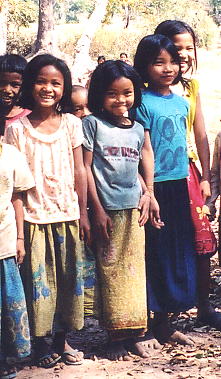
ANDYBROUWER.CO.UK
CAMBODIA TALES 2005 - JANUARY
SCC and Angkor Chum
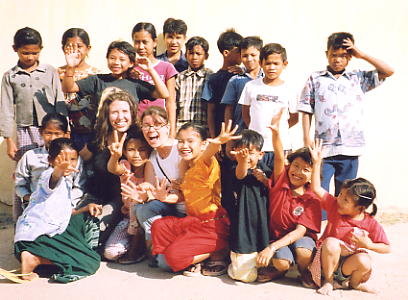 My thirteen hour
Singapore Airlines flight from Heathrow to Changi was on time as
usual, allowing me exactly one hour before my Silk Air connecting
flight to Siem Reap, left at 8.45am. In the queue for the flight
to Cambodia, I bumped into an old pal, Peter Leth, returning to
Phnom Penh from the US and arranged to catch-up later in my trip,
as well as meeting Nancy Beavan, a New Zealand doctor involved in
the carbon-dating of burial jars found in the Cardomom Mountains.
The incoming flight was only a quarter full and after the usual
airport and visa formalities were completed (only eight police
required to process my visa on this occasion), I linked up with
Rieng outside the terminal, a beaming smile from ear to ear as
usual, who'd come to collect me in his father-in-law's shiny
white Toyota Camry. Rieng confirmed that he'd taken leave from
his usual jobs as both a policeman and Angkor guide, to put
himself at
My thirteen hour
Singapore Airlines flight from Heathrow to Changi was on time as
usual, allowing me exactly one hour before my Silk Air connecting
flight to Siem Reap, left at 8.45am. In the queue for the flight
to Cambodia, I bumped into an old pal, Peter Leth, returning to
Phnom Penh from the US and arranged to catch-up later in my trip,
as well as meeting Nancy Beavan, a New Zealand doctor involved in
the carbon-dating of burial jars found in the Cardomom Mountains.
The incoming flight was only a quarter full and after the usual
airport and visa formalities were completed (only eight police
required to process my visa on this occasion), I linked up with
Rieng outside the terminal, a beaming smile from ear to ear as
usual, who'd come to collect me in his father-in-law's shiny
white Toyota Camry. Rieng confirmed that he'd taken leave from
his usual jobs as both a policeman and Angkor guide, to put
himself at 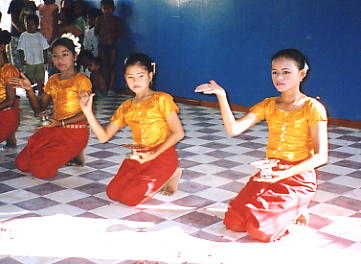 my disposal during my
time in Siem Reap as my guide, driver and friend. We drove to the
HanumanAlaya guesthouse, located in a quiet neighborhood next to
the river and the Angkor Conservation compound and were welcomed
by the efficient receptionist Sina, before a quick-fire visit to
catch-up with Dave and Colleen at their new Peace of Angkor
premises and an invite from two of their guests to visit a school
they'd been volunteers at for the past week. By sheer
coincidence, it was sponsored by Schools for Children of Cambodia
(SCC), a UK charity we'd supported at our Magic of Cambodia day a
few months before and which I'd intended to visit whilst in Siem
Reap to see their worthy efforts at first-hand. So my first
afternoon was now arranged.
my disposal during my
time in Siem Reap as my guide, driver and friend. We drove to the
HanumanAlaya guesthouse, located in a quiet neighborhood next to
the river and the Angkor Conservation compound and were welcomed
by the efficient receptionist Sina, before a quick-fire visit to
catch-up with Dave and Colleen at their new Peace of Angkor
premises and an invite from two of their guests to visit a school
they'd been volunteers at for the past week. By sheer
coincidence, it was sponsored by Schools for Children of Cambodia
(SCC), a UK charity we'd supported at our Magic of Cambodia day a
few months before and which I'd intended to visit whilst in Siem
Reap to see their worthy efforts at first-hand. So my first
afternoon was now arranged.
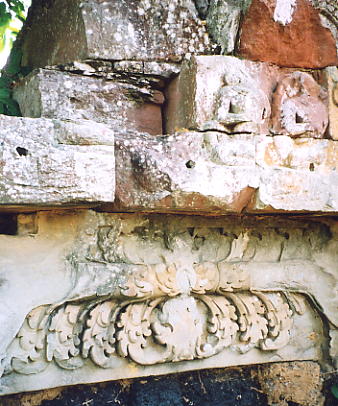 Rieng dropped me near
the old market and I popped into one of the numerous internet
cafes that have sprung up, to let my family know that I'd arrived
safely. Next door I had a relaxing lunch on the balcony of the
Red Piano restaurant before Rieng returned at 2pm and we headed
out along the road towards the Tonle Sap lake. Turning left
across one of the small bridges over the Siem Reap river, we
negotiated a narrow lane until we reached the gates of the Amelio
school in the village of Spean Chreav. Alison and Beth, from New
York and Baltimore respectively, were helping out at the school
whilst on vacation and were busy taping the results of their
photography sessions, working with a group of 11-15 year olds, to
the outside wall of one of the classrooms. Standing closeby were
some of the children, who were clearly pleased with their
handiwork, having taken pictures of family, friends and their
surroundings, and not shy in showing me their favourite photos.
An hour later, Ung Savy, the director of the school and the SCC
representative, arrived with a group
Rieng dropped me near
the old market and I popped into one of the numerous internet
cafes that have sprung up, to let my family know that I'd arrived
safely. Next door I had a relaxing lunch on the balcony of the
Red Piano restaurant before Rieng returned at 2pm and we headed
out along the road towards the Tonle Sap lake. Turning left
across one of the small bridges over the Siem Reap river, we
negotiated a narrow lane until we reached the gates of the Amelio
school in the village of Spean Chreav. Alison and Beth, from New
York and Baltimore respectively, were helping out at the school
whilst on vacation and were busy taping the results of their
photography sessions, working with a group of 11-15 year olds, to
the outside wall of one of the classrooms. Standing closeby were
some of the children, who were clearly pleased with their
handiwork, having taken pictures of family, friends and their
surroundings, and not shy in showing me their favourite photos.
An hour later, Ung Savy, the director of the school and the SCC
representative, arrived with a group 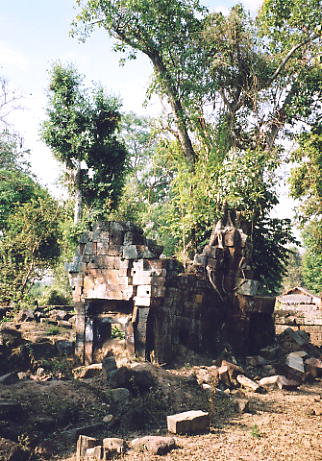 of travellers from the
adventure tour company Intrepid, in time to watch the youngsters
put on a demonstration of five different traditional dances, with
each of the dancers in a colourful costume. Five of the girls
began with the flower dance, followed by a mix of boys and girls
in the coconut, fisherman, butterfly and crab dances. A very
enjoyable hour was rounded off with a ramvong dance which
everyone, children and audience alike, joined in. At 4.30pm we
said our goodbyes to everyone at the school and headed back into
town to visit Rieng's wife, Sovann and family, to make a fuss of
his two year old son Nara and to discuss our temple-hunting plans
for the following day. My evening meal at the Continental Cafe
near the old market was disappointing before a tikalok
fruit-shake on the way back to my guesthouse and an early night
in preparation for the next morning's exploration.
of travellers from the
adventure tour company Intrepid, in time to watch the youngsters
put on a demonstration of five different traditional dances, with
each of the dancers in a colourful costume. Five of the girls
began with the flower dance, followed by a mix of boys and girls
in the coconut, fisherman, butterfly and crab dances. A very
enjoyable hour was rounded off with a ramvong dance which
everyone, children and audience alike, joined in. At 4.30pm we
said our goodbyes to everyone at the school and headed back into
town to visit Rieng's wife, Sovann and family, to make a fuss of
his two year old son Nara and to discuss our temple-hunting plans
for the following day. My evening meal at the Continental Cafe
near the old market was disappointing before a tikalok
fruit-shake on the way back to my guesthouse and an early night
in preparation for the next morning's exploration.
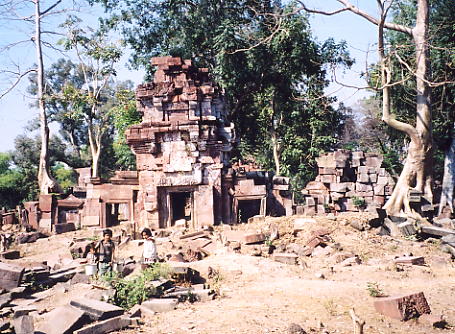 The HanumanAlaya is a quiet and relaxed haven,
tastefully decorated in dark local timbers with cool balconies
and well appointed rooms. Its part of the Hanuman Tourism
operation run by my pals, Nick and Kulikar Ray. Breakfast was
served at 7am by the lovely Borain and Rieng arrived at 7.45
accompanied by his father-in-law Heng driving a 4WD. All my
previous temple expeditions with Rieng had been on his moto, so
this was the height of luxury. The 4WD is owned by a mutual
friend of ours, Merrily Hansen, so it was all above board, and I
settled into the front seat to enjoy the drive and the cool air
con. Our target, as we headed out along Route 6 towards the
airport and beyond, was a handful of temples in the Angkor Chum
district, some 50 kilometres or so northwest of Siem Reap. It
wasn't completely new
The HanumanAlaya is a quiet and relaxed haven,
tastefully decorated in dark local timbers with cool balconies
and well appointed rooms. Its part of the Hanuman Tourism
operation run by my pals, Nick and Kulikar Ray. Breakfast was
served at 7am by the lovely Borain and Rieng arrived at 7.45
accompanied by his father-in-law Heng driving a 4WD. All my
previous temple expeditions with Rieng had been on his moto, so
this was the height of luxury. The 4WD is owned by a mutual
friend of ours, Merrily Hansen, so it was all above board, and I
settled into the front seat to enjoy the drive and the cool air
con. Our target, as we headed out along Route 6 towards the
airport and beyond, was a handful of temples in the Angkor Chum
district, some 50 kilometres or so northwest of Siem Reap. It
wasn't completely new 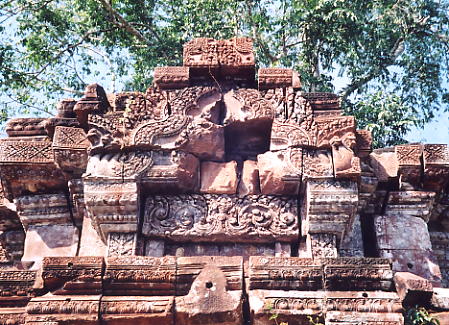 territory for Rieng and
Heng, but it was for me. It took us an hour to reach Sasarsdam,
30 kms from Siem Reap, where we turned right and off the busy
main highway and another thirty minutes to Angkor Chum village,
where we forked left after Donsva school. A nondescript track
towards the village of Koul led first to a small laterite temple
with a surrounding wall, which Rieng named Prasat Takom. Broken
pieces of sandstone lintel littered the floor around a central
tower split in two by a large tree sprouting skywards, an
undamaged laterite library and a ruined gopura [entrance
pavilion]. Rieng, using his knowledge as an Angkor guide, thought
the temple likely to be from the 11th century, though a defaced
floral lintel still in situ was substantially earlier in origin,
probably 9th century. A
territory for Rieng and
Heng, but it was for me. It took us an hour to reach Sasarsdam,
30 kms from Siem Reap, where we turned right and off the busy
main highway and another thirty minutes to Angkor Chum village,
where we forked left after Donsva school. A nondescript track
towards the village of Koul led first to a small laterite temple
with a surrounding wall, which Rieng named Prasat Takom. Broken
pieces of sandstone lintel littered the floor around a central
tower split in two by a large tree sprouting skywards, an
undamaged laterite library and a ruined gopura [entrance
pavilion]. Rieng, using his knowledge as an Angkor guide, thought
the temple likely to be from the 11th century, though a defaced
floral lintel still in situ was substantially earlier in origin,
probably 9th century. A 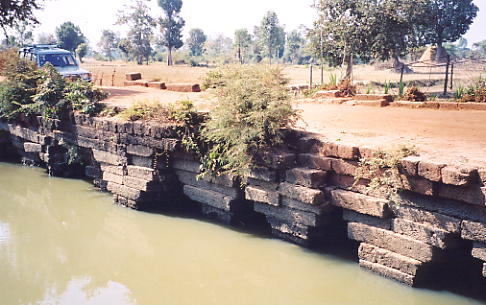 small pool with
laterite steps, just outside the enclosure wall completed the
temple lay-out. As we passed the village of Koul nearby, visible
from the road was a second, considerably larger temple called,
not unsuprisingly, Prasat Koul. Occupying a wide area surrounded
by a sandstone wall, an inner (dry) moat, three large entrance
gates, two libraries, a massive northern gallery wall and a
completely ruined central sanctuary with two entry gopuras,
Prasat Koul still has intricate carvings on its walls and
lintels, which suggests a 12th century construction. In its
hey-day, the temple would have been of a significant size, but
today, it's mostly in pieces. It took us a good forty minutes to
walk the ruins and to chat to a couple of locals who told us that
an intact lion statue had been stolen from the south gate last
year and that the temple was also known locally as Prasat Takom
Thom.
small pool with
laterite steps, just outside the enclosure wall completed the
temple lay-out. As we passed the village of Koul nearby, visible
from the road was a second, considerably larger temple called,
not unsuprisingly, Prasat Koul. Occupying a wide area surrounded
by a sandstone wall, an inner (dry) moat, three large entrance
gates, two libraries, a massive northern gallery wall and a
completely ruined central sanctuary with two entry gopuras,
Prasat Koul still has intricate carvings on its walls and
lintels, which suggests a 12th century construction. In its
hey-day, the temple would have been of a significant size, but
today, it's mostly in pieces. It took us a good forty minutes to
walk the ruins and to chat to a couple of locals who told us that
an intact lion statue had been stolen from the south gate last
year and that the temple was also known locally as Prasat Takom
Thom.
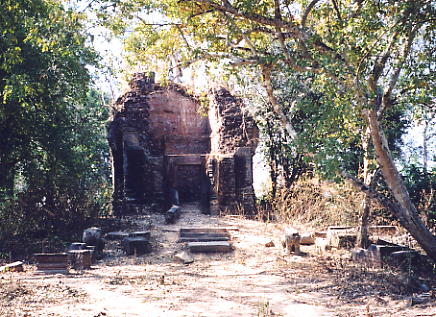 Returning to the main road, we carried on til we
came to a sizeable and sturdily-built Angkorean laterite bridge,
Spean Thma, spanning a wide river with a broken naga body along
the roadside. We counted twelve arches though with the water
level still quite high for the time of year, it restricted any
closer inspection. Retracing our steps and stopping for
directions, Rieng recognised one of the moto-drivers at the
Angkor Chum crossroads as the local police deputy and asked
whether any other 'prasats' were nearby. With much arm waving,
pointing and friendly arguments over names, we were soon on our
way, making a left turn along a bumpy and sandy track, heading
for Prasat Trav. Half an
Returning to the main road, we carried on til we
came to a sizeable and sturdily-built Angkorean laterite bridge,
Spean Thma, spanning a wide river with a broken naga body along
the roadside. We counted twelve arches though with the water
level still quite high for the time of year, it restricted any
closer inspection. Retracing our steps and stopping for
directions, Rieng recognised one of the moto-drivers at the
Angkor Chum crossroads as the local police deputy and asked
whether any other 'prasats' were nearby. With much arm waving,
pointing and friendly arguments over names, we were soon on our
way, making a left turn along a bumpy and sandy track, heading
for Prasat Trav. Half an 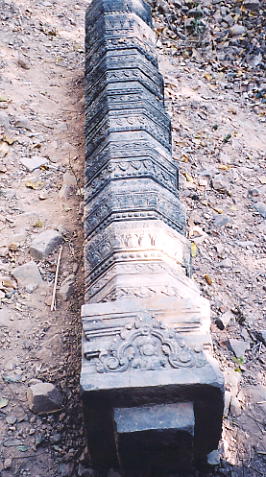 hour later we arrived
at Trav village and standing on a small rise amongst trees behind
the school was the temple, surrounded by the indentation of a dry
moat. A large single brick tower, destroyed above the main
doorway and lacking a roof, it did still house two intricately
carved colonettes, an inscription in Khmer on the doorframe,
three false doors, two pedestals and two headless lions guarding
the entrance. Not long after our arrival, a group of twenty or so
children appeared to see what all the fuss was about, as we
decided to take a rest and have our lunch - Rieng had packed rice
and chicken, as well as an icebox with drinks - in the shade of
the ancient temple. Fed and watered, we then headed for a temple
that the police deputy had
hour later we arrived
at Trav village and standing on a small rise amongst trees behind
the school was the temple, surrounded by the indentation of a dry
moat. A large single brick tower, destroyed above the main
doorway and lacking a roof, it did still house two intricately
carved colonettes, an inscription in Khmer on the doorframe,
three false doors, two pedestals and two headless lions guarding
the entrance. Not long after our arrival, a group of twenty or so
children appeared to see what all the fuss was about, as we
decided to take a rest and have our lunch - Rieng had packed rice
and chicken, as well as an icebox with drinks - in the shade of
the ancient temple. Fed and watered, we then headed for a temple
that the police deputy had 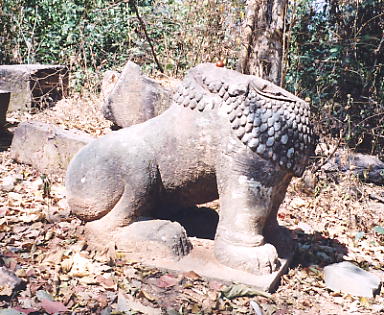 identified, though it
took an hour by 4WD to reach it via a series of bumpy tracks. We
arrived at Wat Kralanh just after 2pm to find a new wat under
construction on top of the laterite base of a much older temple.
At the front of the wat, a broken lion and naga antefix's
[decorative corner pieces] provided some evidence, whilst behind
the new building, the remains of one wall of a small brick tower
stood in the shade. Not one of my greatest discoveries but if you
don't look, you might just miss a real gem! We headed back
towards Angkor Chum and enroute encountered the waves and giggles
of
identified, though it
took an hour by 4WD to reach it via a series of bumpy tracks. We
arrived at Wat Kralanh just after 2pm to find a new wat under
construction on top of the laterite base of a much older temple.
At the front of the wat, a broken lion and naga antefix's
[decorative corner pieces] provided some evidence, whilst behind
the new building, the remains of one wall of a small brick tower
stood in the shade. Not one of my greatest discoveries but if you
don't look, you might just miss a real gem! We headed back
towards Angkor Chum and enroute encountered the waves and giggles
of 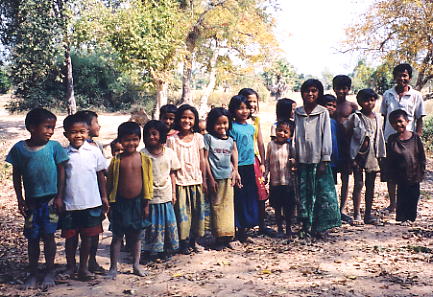 a female road-building
crew, a fairly familiar sight across Cambodia as young girls,
their faces protected from the sun by hats and scarves, spend
their day filling, carrying and depositing baskets of tiny stones
on the new road surface.
a female road-building
crew, a fairly familiar sight across Cambodia as young girls,
their faces protected from the sun by hats and scarves, spend
their day filling, carrying and depositing baskets of tiny stones
on the new road surface.
Heng, clearly an expert driver
though limited in his spoken English, suggested that we call into
see one of his daughters, Dari, a teacher at the village school
of Kdei Run, which was on our way back to the main highway.
Unfortunately Dari was visiting a friend nearby after only two of
her pupils arrived for lessons that day and her class had been
cancelled. Whilst we 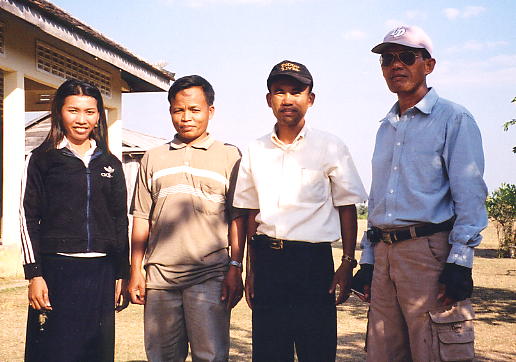 waited for her to
return, the school's director, Nhien Bun Tay proudly informed us
that the school caters for nearly 700 pupils at various times, in
eight classrooms, half of which were open-sided wooden rooms,
with a staff of ten part-time female teachers. Dari, who lives in
Siem Reap with her parents and extended family, later explained
that the trip to the school takes her two hours each way by moto,
and unable to get a teaching job in town, she had to take up this
post a few months earlier. A similar story
waited for her to
return, the school's director, Nhien Bun Tay proudly informed us
that the school caters for nearly 700 pupils at various times, in
eight classrooms, half of which were open-sided wooden rooms,
with a staff of ten part-time female teachers. Dari, who lives in
Siem Reap with her parents and extended family, later explained
that the trip to the school takes her two hours each way by moto,
and unable to get a teaching job in town, she had to take up this
post a few months earlier. A similar story 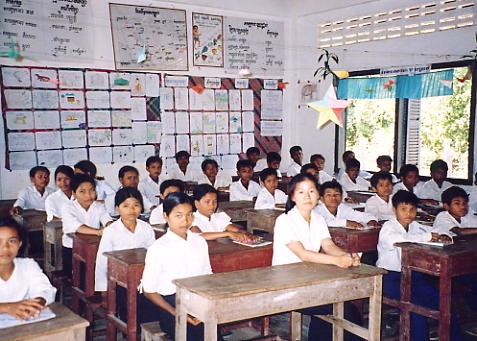 was told by Kunthear,
who couldn't get a job in her hometown of Kompong Kdei and moved
to Sasardam for this post. Twenty years old and one of three
teachers in her family, she introduced me to her class for an
impromptu lesson of repeating words as I said them and then the
bravest of the pupils asked the usual questions, such as, what's
your name, etc. The school closed early so the teachers could go
home in the late afternoon light and whilst Dari donned her
crash-helmet for the long journey home, we gave Kunthear a lift
to Sasardam, and arrived back in Siem Reap just before 6pm.
was told by Kunthear,
who couldn't get a job in her hometown of Kompong Kdei and moved
to Sasardam for this post. Twenty years old and one of three
teachers in her family, she introduced me to her class for an
impromptu lesson of repeating words as I said them and then the
bravest of the pupils asked the usual questions, such as, what's
your name, etc. The school closed early so the teachers could go
home in the late afternoon light and whilst Dari donned her
crash-helmet for the long journey home, we gave Kunthear a lift
to Sasardam, and arrived back in Siem Reap just before 6pm.
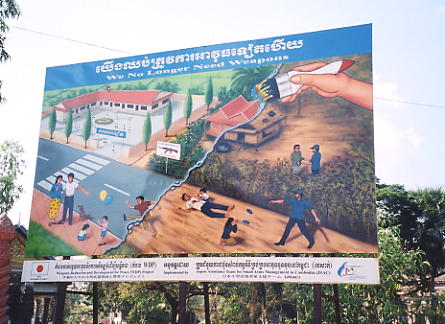 Overall, a pleasant day
trip with Rieng and Heng to a new location. The 4WD doesn't
protect you from the bumpy road, despite Heng's expertise, but it
does keep the sun off and the dust out and so early in my trip, I
was grateful for that. On previous occasions, a day out looking
for temples with Rieng [on his moto] would usually result in
being covered in a layer of red dust and my face already turning
bright pink from the sun. A Pre-Angkor Conference taking place at
the Center for Khmer Studies had attracted lots of key scholars
and amongst them, Dawn Rooney, author of the widely-read and
photocopied Angkor, and a guest speaker at the Magic of Cambodia
day, was in town and I paid her a visit at the Royal Crown hotel
for a chat before eating alone at the Red Piano restaurant,
quickly becoming my favourite eatery, checked my e-mail next door
and finished the evening with a tikalok at a stall along the road
to the temples, before retiring to bed at 9.30pm.
Overall, a pleasant day
trip with Rieng and Heng to a new location. The 4WD doesn't
protect you from the bumpy road, despite Heng's expertise, but it
does keep the sun off and the dust out and so early in my trip, I
was grateful for that. On previous occasions, a day out looking
for temples with Rieng [on his moto] would usually result in
being covered in a layer of red dust and my face already turning
bright pink from the sun. A Pre-Angkor Conference taking place at
the Center for Khmer Studies had attracted lots of key scholars
and amongst them, Dawn Rooney, author of the widely-read and
photocopied Angkor, and a guest speaker at the Magic of Cambodia
day, was in town and I paid her a visit at the Royal Crown hotel
for a chat before eating alone at the Red Piano restaurant,
quickly becoming my favourite eatery, checked my e-mail next door
and finished the evening with a tikalok at a stall along the road
to the temples, before retiring to bed at 9.30pm.
Here's links to the rest of my Cambodia Tales.
January 2005 marked my eleventh trip to Cambodia since my first-ever visit in 1994. It's a country that has a special magic all of its own and which draws me back every year to venture out into the Cambodian countryside in search of new adventures, ancient temples and to catch up with the friends I've made from previous visits. Each trip is full of laughter, smiles and a host of fresh experiences and my latest expedition was no exception.
Home : Next : Messageboard : 2005 : E-mail
The contents of this website cannot be reproduced or copied without permission of the site author. (c) Andy Brouwer 2005
Click to enlarge all photos. Click 'refresh' if photos do not fully load.